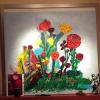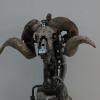I had a thread posted here awhile ago on photobiomodulation using Near Infared LEDs. They have been shown in vivo to accelerate wound healing time in diabetic ulers as well as decrease chick mortality in the egg stage.
here are a few links that are relevant
Near infrared light protects cardiomyocytes from hypoxia and reoxygenation injury by a nitric oxide dependent mechanism.
Zhang R, Mio Y, Pratt PF, Lohr N, Warltier DC, Whelan HT, Zhu D, Jacobs ER, Medhora M, Bienengraeber M.
Department of Medicine, Medical College of Wisconsin, Milwaukee, WI 53326, USA; Department of Pharmacology, College of Pharmacy, Harbin Medical University, Harbin, 150086, China.
Photobiomodulation with near infrared light (NIR) provides cellular protection in various disease models. Previously, infrared light emitted by a low-energy laser has been shown to significantly improve recovery from ischemic injury of the canine heart. The goal of this investigation was to test the hypothesis that NIR (670 nm) from light emitting diodes produces cellular protection against hypoxia and reoxygenation-induced cardiomyocyte injury. Additionally, nitric oxide (NO) was investigated as a potential cellular mediator of NIR. Our results demonstrate that exposure to NIR at the time of reoxygenation protects neonatal rat cardiomyocytes and HL-1 cells from injury, as assessed by lactate dehydrogenase release and MTT assay. Similarly, indices of apoptosis, including caspase 3 activity, annexin binding and the release of cytochrome c from mitochondria into the cytosol, were decreased after NIR treatment. NIR increased NO in cardiomyocytes, and the protective effect of NIR was completely reversed by the NO scavengers carboxy-PTIO and oxyhemoglobin, but only partially blocked by the NO synthase (NOS) inhibitor L-NMMA. Mitochondrial metabolism, measured by ATP synthase activity, was increased by NIR, and NO-induced inhibition of oxygen consumption with substrates for complex I or complex IV was reversed by exposure to NIR. Taken together these data provide evidence for protection against hypoxia and reoxygenation injury in cardiomyocytes by NIR in a manner that is dependent upon NO derived from NOS and non-NOS sources.
1: J Photochem Photobiol B. 2008 Sep 18;92(3):144-52. Epub 2008 Jul 7.Click here to read Links
Influence of laser photobiomodulation upon connective tissue remodeling during wound healing.
Medrado AP, Soares AP, Santos ET, Reis SR, Andrade ZA.
Laboratory of Experimental Pathology, Oswaldo Cruz Foundation, Rua Waldemar Falcão, 121, Salvador, Bahia 40.296-710, Brazil. alenamedrado@hotmail.com
The modulation of collagen fibers during experimental skin wound healing was studied in 112 Wistar rats submitted to laser photobiomodulation treatment. A standardized 8mm-diameter wound was made on the dorsal skin of all animals. In half of them, 0.2ml of a silica suspension was injected along the border of the wound in order to enhance collagen deposition and facilitate observation. The others received saline as vehicle. The treatment was carried out by means of laser rays from an aluminum-gallium arsenide diode semiconductor with 9mW applied every other day (total dose=4J/cm2) on the borders of the wound. Tissue sections obtained from four experimental groups representing sham-irradiated animals, laser, silica and the association of both, were studied after 3, 7, 10, 15, 20, 30 and 60 days from the laser application. The wounded skin area was surgically removed and submitted to histological, immunohistochemical, ultrastructural, and immunofluorescent studies. Besides the degree and arrangement of collagen fibers and of their isotypes, the degree of edema, the presence of several cell types especially pericytes and myofibroblasts, were described and measured. The observation of Sirius-red stained slides under polarized microscopy revealed to be of great help during the morphological analysis of the collagen tissue dynamic changes. It was demonstrated that laser application was responsible for edema regression and a diminution in the number of inflammatory cells (p<0.05). An evident increase in the number of actin-positive cells was observed in the laser-treated wounds. Collagen deposition was less than expected in silica-treated wounds, and laser treatment contributed to its better differentiation and modulation in all irradiated groups. Thus, laser photobiomodulation was able to induce several modifications during the cutaneous healing process, especially in favoring newly-formed collagen fibers to be better organized and compactedly disposed.
Photomed Laser Surg. 2006 Jun;24(3):410-3.Click here to read Links
Brief report: embryonic growth and hatching implications of developmental 670-nm phototherapy and dioxin co-exposure.
Yeager RL, Franzosa JA, Millsap DS, Lim J, Hansen CM, Jasevicius AV, Heise SS, Wakhungu P, Whelan HT, Eells JT, Henshel DS.
School of Public and Environmental Affairs, Indiana University, Bloomington, Indiana 47405, USA. rlyeager@indiana.edu
OBJECTIVE: We assessed the effect of 670-nm light therapy on growth and hatching kinetics in chickens (Gallus gallus) exposed to dioxin. BACKGROUND DATA: Photobiomodulation has been shown to stimulate signaling pathways resulting in improved energy metabolism, antioxidant production, and cell survival. In ovo treatment with 670-nm light-emitting diode (LED) arrays improves hatching success and increases hatchling size in control chickens. Under conditions where developmental dioxin exposure is above the lethality threshold (100 ppt), phototherapy attenuates dioxin-induced early embryonic death. We hypothesized that 670-nm LED therapy would attenuate dioxin-induced developmental anomalies and increase hatching success. METHODS: Fertile chicken eggs were injected with control oil, 2, 20, or 200 ppt dioxin, or 2,3,7,8-tetrachlorodibenzo-p-dioxin (TCDD) prior to the start of incubation. Half of the eggs in each dose group were treated once per day from embryonic days 0-20 with 670-nm LED light at a fluence of 4 J/cm2. Hatchling size, organ weights, and energy parameters were compared between dose groups and LED treatment. RESULTS: LED therapy resulted in earlier pip times (small hole created 12-24 h prior to hatch), and increased hatchling size and weight in the 200 ppt dose groups. However, there appears to be an LED-oil interaction within the oil-treated controls that results in longer hatch times and decreased liver weight within the LED control dose groups in comparison to the non-LED control dose groups. CONCLUSION: Size and hatching times suggest that the hatching success and preparedness of chicks developmentally exposed to dioxin concentrations above the lethality threshold is improved by 670-nm LED treatment administered throughout the gestation period, but the relationship may be complicated by an LED-oil interaction.
My question to you guys is how this may be relevant to general anti aging procedures in the near future and possible complimenting therapies to use along side it.
this quote seems to indicate there are FAR ranging uses for this technology and for many of the diseases we associate with aging,
Gene discovery studies conducted using microarray technology documented a significant upregulation of gene expression in pathways involved in mitochondrial energy production and antioxidant cellular protection. These findings provide a link between the actions of red to near infrared light on mitochondrial oxidative metabolism in vitro and cell injury in vivo. Based on these findings and the strong evidence that mitochondrial dysfunction is involved in the pathogenesis of numerous diseases processes, we propose that NIR-LED photobiomodulation represents an innovative and non-invasive therapeutic approach for the treatment of tissue injury and disease processes in which mitochondrial dysfunction is postulated to play a role including diabetic retinopathy, age-related macular degeneration, Leber's hereditary optic neuropathy and Parkinson's disease."
IMO, it could be a phenomenal tool to use as a supplement to other therapies, stem cell, gene therapies, and conventional anti aging supplements such as NtBHA, ALCAR, and soon to be SRT-501.
what do you guys think?
















































